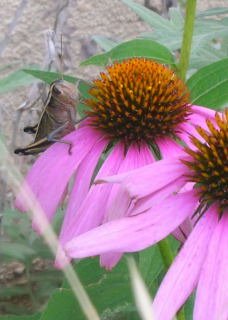 What’s blooming in the area: Fern-leaved globeflower, wooly loco, local dandelion, Apache plume, four winged saltbush, needle grass, downy chess grass, three-awn grass, June grass, catalpa trees
What’s blooming in the area: Fern-leaved globeflower, wooly loco, local dandelion, Apache plume, four winged saltbush, needle grass, downy chess grass, three-awn grass, June grass, catalpa treesWhat’s blooming in my garden, looking north: Yellow iris, red hot poker, golden spur columbine, a few lance-leaf coreopsis, single red rose rootstock, first chocolate flowers, perky Sue, Hartweg evening primrose
Looking east: Winecup, 1 pink evening primrose, small-leaved soapwort, creeping baby’s breath, coral bells, cheddar pink, rock rose, sea pink
Looking south: Remains of spiraea, rugosa rose
Look west: 1 starflower (Ixioiorion pallarsii)
Animal sightings: Humming birds, quail, geckos, grasshoppers, ants, blue dragonfly
Weather: Hot during day, cool at night, strong winds in afternoon, no moisture
Weekly update: Grasshoppers are attacking early this year. Usually they appear in mid-summer, fully grown. This year, they started eating when they were 1/4" long.
After several years respite, they were particularly destructive last year. They ate most of the leaves from every tree and shrub in my yard, leveled stands of blue flax, hollyhocks, coreopsis, tansy, columbine, and iris, then finished off most everything else that grew. The only thing they didn’t eat was the grass.
Fortunately, there was a long, cool fall after they died out, and the trees and shrubs were able to recover. None died, but there are leafless spaces and dead limbs. The apple trees had no flowers this spring, the peach only a few.
The insects were followed by a cold, dry winter that killed back herbaceous perennials that normally stay green in winter. Plants that were weakened, haven’t come back. Yellow yarrow and Rumanian salvia never survive such winters, and blue flax is only now putting out new sprouts. Normally it would have been blooming for a month.
I decided, this year, I have no choice but to attack the grasshoppers. I haven’t in the past, less because I distrust chemical insecticides, than because I’m lazy. I never can get sprayers to work without getting doused, and so avoid them. Using powders means walking through the yard scattering granules by hand. When the yard is bunch grass, and gets 2' to 4' high, a lawn spreader is not an option.
However, this year it’s do it, or lose everything. I put out two butterfly bushes one Sunday two weeks ago; on Tuesday there were no leaves. I bought an insecticide spray at the local hardware, and apparently got rid of enough insects to save the plants.
Then I put out some marigolds last weekend, and a few days later there was little left of the ones nearest the front of the bed. I told a friend I was leaving work early to buy something at the big box, and she called a friend who told her the best natural insecticide. When I called the local nursery, they hadn’t heard of it. So, I bought the first bag of insecticide I could find, and scattered it with a saucepan in the area.
Then, I went on the internet to see what I should use. The USDA website was devoted to range management. Apparently their solution is get rid of grass. That’s what most of my neighbors do. It’s difficult to level a house site here and keep the native vegetation, so by default their houses are surrounded by dirt that blows in the wind. They may have no grasshoppers, but they have pig weed and Russian thistle, the first plants back in disturbed soil.
Most of the natural controls I saw on the web use organisms that sink into the soil to be eaten by grasshoppers when they’re in their grub or larva stage. That apparently occurs between March and May. Not much help now, but certainly something I will consider later this year. The last infestation lasted several years and only disappeared when a large flock of migrating birds spent a week in the fields clearing everything out. Nature may be self-correcting, but her timing is haphazard.
I looked to see what, if anything was offered by the various nursery catalogs that sell seeds or plants. Apparently greenhouses don’t worry about grasshoppers, and so none of their catalogs listed any of the available organisms. However, I now know where to buy worm casings, ladybugs, and predatory nematodes. I thought the point of marigolds was to control nematodes.
One company did advertise garlic spray, and said it worked in their greenhouses. They thought the smell might be important. I read a recipe for garlic spray on the web that was far more complicated than I was willing to try, so I bought some garlic and threw the cloves around key plants. I figured the worst that could happen is the rabbit would get bad breath.
So, I went back to the big box to see what was available. They had several brands of grass insecticide granules, but only one listed grasshoppers. The active ingredient in each was a synthetic form of pyrethrin. The natural extract loses its power quickly in the sunlight, and would never work in this near desert. Besides, the grasshoppers ate a dozen10-year old chrysanthemum plants last year before they could flower. But pyrethroids can be toxic to birds, including quail which do choose to walk rather than fly in my yard.
A few days later, the area where I scattered the insecticide no longer hops with insects, and the area by my garage is as active as a mosquito swamp in south Jersey. Apparently, it is doing some good. We’ll see how long before the insecticide deteriorates, new insects hatch or adults migrate in. Meantime, the victimized marigolds are beginning to put out new leaves. The first small victory in what’s going to be a very long summer.